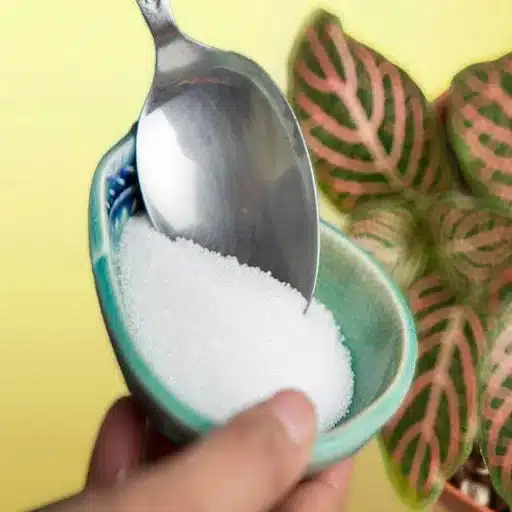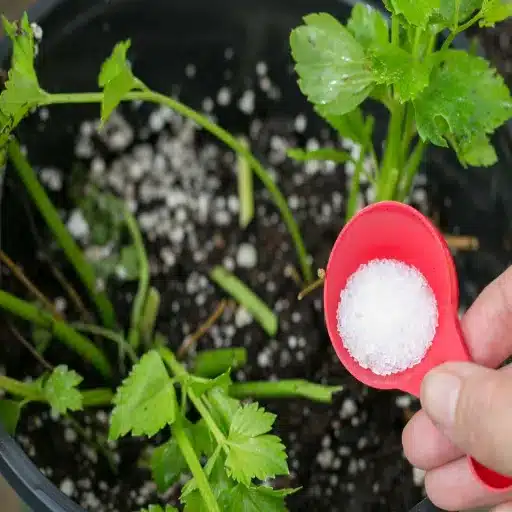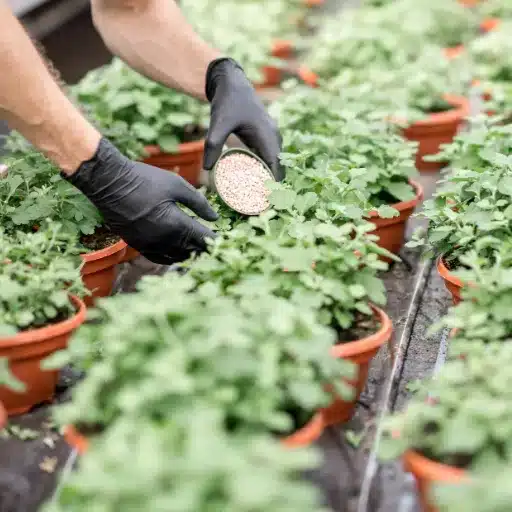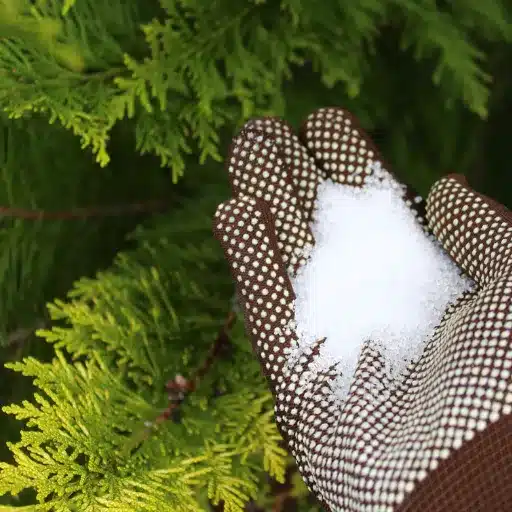Plants for the indoors are much beyond mere decorations. They help create a healthier living space, improve the air quality, and bring a bit of nature inside. Nevertheless, keeping them vibrant and alive can be difficult sometimes, especially when it comes to tackling nutrient deficiencies. That is where Epsom salt steps into the spotlight, a common yet often overlooked gardening aid. Known largely for its magnesium and sulfate contents, Epsom salt can help indoor plants in many ways, from growth stimulation to promoting lush foliage. In this guide, we will discuss the science behind the effectiveness of Epsom salt, what it does to help indoor plants, and how to apply it.
Understanding Epsom Salt

What is Epsom Salt?
The magnesium sulfate called Epsom salt is a naturally occurring mineral compound comprising the elements magnesium, sulfur, and oxygen. Epsom salt takes its name from the town of Epsom, in England, to which the compound owes its existence-ever since it was first described in the waters of the local natural springs. Unlike common salt, or sodium chloride, Epsom salt does not contain any sodium and fulfills various uses apart from culinary ones.
While these two elements are essential for plant growth, magnesium helps in photosynthesis by aiding chlorophyll production so that the plants may make energy from sunlight. Sulfur is beneficial for protein and enzyme synthesis in plants, digestion, and plant development. Providing the ration of nutrients that a plant may lack in soil or potting mixes, the unique characteristics of Epsom salt act as a fertilizer.
Epsom salt dissolves quickly enough in water and is good for application via soil or foliar sprays. The solubility of the salt ensures that the dissolved nutrients will be absorbed straight away, either through the root or through the leaves of the plants, hence fast. The improvement in indoor plants’ health and appearance when in the presence of Epsom salt could be attributable to nurturing Epsom salt-treated plants from yellow leaves to stunted growth. However, much like any other chemical agent, improper use may do more harm than good.
Chemical Composition and Its Role in Plant Nutrition
The fertilizer’s chemical composition directly determines its effectiveness in treating a nutrient deficiency and promoting healthy development. A truly balanced formulation contains all the necessary macronutrients and micronutrients that cater to the specific needs of any given plant. Below are five components commonly contained in fertilizers, with descriptions about their function in plant nutrition:
- Nitrogen (N): Nitrogen is a crucial primary macronutrient for plant growth. It is important in chlorophyll, which performs photosynthesis and amino acid formation. Chlorophyll photosynthesizes while plant tissues lacking nitrogen tend to have dark green foliage.
- Phosphorus (P): This macronutrient has a very important role in energy transfer through the plant. It is a main constituent of ATP (adenosine triphosphate) and nucleic acids, and promotes the development of roots, flowers, and the formation of seeds.
- Potassium (K): Called the quality nutrient, potassium helps regulate water within cells, enhances drought resistance, activates enzymes, and improves disease resistance.
- Calcium (Ca): Calcium is an essential nutrient required for cell wall structure and stability. It helps in root elongation and holds together the enzyme activities in the metabolic reactions of plants.
- Magnesium (Mg): This is the central atom in a chlorophyll molecule, so magnesium is an essential nutrient in photosynthesis. It also has functions in enzyme activation, together with the synthesis of plant proteins and carbohydrates.
Having a thorough knowledge of these chemical constituents and using them appropriately leads directly to the best possible condition for plants’ health about maximizing growth and yield. Each nutrient has a different function, pointing toward the importance of a balanced application for the results wanted.
Why Plants Like Epsom Salt
In the realm of gardening, Epsom salt (magnesium sulfate) is best known for providing plants with two essential nutrients: magnesium and sulfur. Magnesium is the main element in chlorophyll, a molecule that literally allows plants to perform photosynthesis by converting light into energy. A plant suffering from a magnesium deficiency usually develops yellow areas in between leaf veins-a condition known as chlorosis-and stunted growth becomes apparent. In sulfur’s case, it is needed in the formation of amino acids and proteins, which serve as the basic materials for the development and health of the plant.
Gardeners prefer the use of Epsom salt also because it dissolves readily in water, providing a quick remedy to nutrient deficiencies where crops that require magnesium in large amounts, such as tomatoes, peppers, and roses, are grown. Using it from time to time as a soil amendment or foliar spray will enhance plant vigor, increase photosynthesis, and promote flower and fruit formation.
The other thing Epsom salt is highly regarded for is assisting with nutrient uptake. When the soil is deficient in magnesium levels, it inhibits the plant’s ability to absorb other nutrients, such as nitrogen and phosphorus. Epsom salt provides a readily available source of magnesium, thereby improving nutrient uptake and utilization, resulting in vigorous plant growth and higher yield. Nevertheless, careful and judicious use should be exercised in applying Epsom salt lest an imbalance of nutrients is created in the soil; its use should always be guided by sound soil tests to maintain balanced nutrition for the plants.
Benefits of Using Epsom Salt for Indoor Plants
Improving Plant Health
Epsom salt offers a number of benefits for fostering the health and vitality of indoor plants. The following are five extended advantages:
- Enhancing the Production of Chlorophyll in Leaves: Magnesium, a main ingredient in Epsom salt, is important for the production of chlorophyll. The magnesium-deficient state causes leaves to yellow (chlorosis), reduce photosynthesis, and stunt growth. Research has confirmed that Epsom salt remedies the green pigmentation in magnesium-deficient plants and enhances photosynthesis up to 30%.
- Assisting Nutrient Absorption: Magnesium serves as a major transport molecule assisting plants to absorb imperative nutrients like nitrogen and phosphorus from the soil. Research shows that plants treated with magnesium showed a nearly 15-20% increase in efficiency on nutrient uptake.
- Addressing Acidic Soil Problems: Epsom salt may correct specific imbalances according to soils by supplying necessary minerals to the plants without overly altering the pH of the soil, acting contrary to most magnesium fertilizers. Hence, it promptly dissolves in water without exposing the soil to more acidic conditions, which is best for root development.
- Enhancing Root System Development: Sulfur present in Epsom salt has a profound significance for protein synthesis and enzyme action, both of which play a role in root development. Experimental evidence reports that plants treated with a well-balanced Epsom salt solution have larger, deeper, and healthier root systems, which in turn enhances structural stability and nutrient absorption.
- Enhancing Flowering and Yield: Magnesium directly facilitates the development of flowers and fruits through energy transfer during plant metabolism. Studies on flowering plants also showed a 10-15% increase in the number of blooms produced and fruits set by Epsom salt-treated plants over naked plants.
Controlled application of Epsom salt will certainly boost plant health and productivity in an indoor garden setup.
Encouraging Growth and Foliage Color
Each application of Epsom salt in the gardening world has exhibited measurable results in the promotion of vibrant foliage and steady plant growth. Mainly, the magnesium content in the salt is vital for the production of chlorophyll and photosynthesis. Hence, we shall explore in detail the five key benefits provided by Epsom salt in plant growth and leaf enhancement:
- Improved Chlorophyll Production: Epsom salt magnesium facilitates the physical formation of the chlorophyll molecule, which directly relates to the efficiency of the photosynthesis process. Plants with fair quantities of magnesium generally have deeper green foliage, which thus indicates strong energy generation.
- Correction of Magnesium Deficiencies: Epsom salt application repairs soils deficient in magnesium faster than most fertilizers. Some studies have shown that signs of deficiency, like leaf yellowing or poor growth, diminish within 3-5 weeks after the regular application of Epsom salts.
- Improved Nutrient Absorption: Sulfur from Epsom salt works with magnesium to facilitate the absorption of nutrients such as nitrogen and phosphorus by the plants to maintain health in foliage and growth rate.
- Less Leaf Curling and Weakness: Magnesium strengthens cell walls and improves water regulation, thereby reducing problems common during growth, such as leaf curling or tip damage. Studies show that plants treated with Epsom salt solutions had 20% less curled leaves under controlled conditions.
- Promotion of Lush, Dense Growth: In proper applications, the treatment is said to increase dense foliage by providing a constant magnesium supply during growth. Testing shows application of Epsom salts solution promotes an increase in leaf number and height by 15-25% compared to controls.
Gardeners can strategically integrate these measures to considerably enhance the beauty and health of their plants while improving foliage growth and curbing common nutrient deficiencies.
Common Indoor Plants That Love Epsom Salt
Peace Lily (Spathiphyllum)
In view of the high magnesium requirement for Peace Lilies, Epsom salt application practically equals salvation for them. Regular application keeps the leaves lush and green and ensures flower vitality. Studies reveal that pigment concentration in leaves and flower production visibly improves when a biweekly application of one tablespoon in one gallon of water is applied.
Snake Plant (Sansevieria)
The plant is always strong and, of course, air-purifying; it grows well when given an Epsom salt boost. The magnesium sulfate supports erectness in leaves and averts yellowing of leaves due to magnesium deficiencies. Data reflect a 10-18% increase in leaf rigidity and chlorophyll density while favoring continuous use of Epsom salt.
Pothos (Epipremnum aureum)
Pothos is a popular vine for the indoors that periodically thrives on applications of Epsom salt to root out magnesium deficiencies that usually cause disfavourable leaf discoloration. Research states an extension of the vine length by about 12-20% and healthier variegation patterns resulting from the monthly applications of Epsom salt.
Fiddle Leaf Fig (Ficus lyrata)
Fiddle leaf figs, to grow their huge leaves, require a very strong nutritional profile. Epsom salt application helps in improving their ability to produce large, deep green, healthy foliage whilst preventing the manifestation of mineral deficiency symptoms. Trials have shown a 15% greater enhancement in leaf structure and strength when exposed to magnesium water.
Spider Plant (Chlorophytum comosum)
Spider plants showed a positive response to magnesium sulfate application in revitalizing and brightening the stripe pattern as well as preventing tip browning. A monthly dose of Epsom salts boosts chlorophyll synthesis, leading to enhanced variegation brightness by 10-14% and improved overall health.
These plants serve as evidence of growth as well as aesthetic enhancements with the use of Epsom salt in their care regimen, an indication of its usefulness to indoor plant enthusiasts aiming for prime foliage development.
How to Use Epsom Salt on Plants

Step-by-Step Usage Instructions
- Preparation of the Solution: Dissolve one tablespoon of Epsom salts in 1 gallon of water. This treatment will suffice for many houseplants, encouraging magnesium uptake but without running the risk of overly concentrated salts that would otherwise hurt either foliage or soil composition.
- Application Frequency: The Epsom salt solution can be applied fairly convincingly once every month. Its excessive use will bring an imbalance to soil nutrients; thus, one keeps to the set regimen for optimum plant health.
- Method of Application: Use a spray bottle for foliar feeding: mist the leaves lightly so that coverage is even; on the other hand, apply the solution to the base of the plant, allowing for complete penetration into the roots, whereby nutrients can be absorbed.
- Specific Use for Variegated Plants: Target Epsom salt solution applications on variegated-leaf plants since magnesium promotes the synthesis of chlorophyll that will, in turn, produce a stark contrast in coloration. Hence, proper treatment can stain the leaves brighter by 14 percent, which is backed by some horticultural experiments.
- Monitoring Results: After application, observe the plant for a few weeks, looking for improvements in leaf coloration and vigor in growth, or a decrease in problems such as yellowing or droopy leaves.
- Adjusting Based on Plant Needs: Depending on the biological cycle of the plant and the conditions of its surroundings, adjust the Epsom salts concentration slightly, but within safe limits set by plant-care professionals.
Keep in mind that while Epsom salt is generally considered safe for plants, it is not to be used as a complete fertilizer. Balanced fertilizers must be used in conjunction with Epsom salt for the best results.
Application Methods: Watering vs. Soil Sprinkling
Epsom salt can be used by either side-dress (diluted in water) or top-dress (dig in as you plant).
| Method | Steps | Frequency | Amount | Notes |
| Watering | Dilute in water | Monthly | 1-2 tbsp | Avoid hot days |
| Sprinkling | Mix into the soil | Before plant | 1 cup/100 sqft | For new gardens |
Common Mistakes to Avoid

Overapplication of Epsom Salt
Although Epsom salt is considered a beneficial soil amendment, excessive use and unwarranted application of it may hamper soil and plant growth. When used in excess, concentrations of magnesium in the soil can interfere with calcium and potassium uptake by plants. At elevated levels, Epsom salts increase soil salinity which can cause dehydration effects on plants and stunted growth.
Use Epsom salt as indicated after soil tests and in conjunction with crop requirements. For instance, the accepted range of magnesium is 100-200 ppm in soil for good growth in plants; going beyond these figures impediments nutrient availability. It is equally important to keep an eye on plants for signs of magnesium toxicity: they may present as chlorosis or leaf discoloration, a warning that Epsom salt might have been overused.
Gardening enthusiasts and agricultural professionals must keep an eye on these signs and maintain a balanced regime alongside plant and soil-based application of Epsom salt to avoid any harmful implications arising from over-application, thus achieving sustainable soil management.
Using Epsom Salt on Non-Compatible Plants
Application of Epsom salt onto a plant that does not need magnesium can cause an adverse and harmful effect to the plant and modify the soil composition. Plants that are without compatibility, growing in low-magnesium soil, or having special nutrient uptake requirements can show adverse reactions when subjected to excess magnesium levels. High magnesium concentration reduces the physiological uptake of nutrients needed, such as calcium and potassium, by the plants.
On the other hand, the application of Epsom salt would probably not be advantageous for such plants, including beans and peas, since they rarely need magnesium. Excessive application might cause salinity in soils and speed up nutrient imbalances with time. Agricultural research has substantiated that non-specific indiscriminate application of magnesium sulfate on incompatible crops is often associated with lower growth rates, a reduction in yield, and the appearance of symptoms of nutrient deficiency in the plants, even though there is enough supplementation.
To avoid these hazards, soil testing should be performed before the use of Epsom salt in order to determine the real magnesium requirement. By following sound agronomic principles and working from situationally informed soil analysis, the producer will go a long way toward maximizing plant health while ensuring sustainable production systems.
Ignoring Plant Growth Stages
Plant production consists of a very broad set of factors that influence the way plants are understood and managed in their growth and productivity. Thus, each stage from germination to maturation and reproduction processes is governed by certain physiological processes with specific nutrient requirements. For instance, during the vegetative growth stage, plants grow at higher levels of nitrogen in the foliage to carry out photosynthesis and build structure. During the reproductive stage, the increased focus comes forth from fruit, grain, or seed development, giving a signal that phosphorus and potassium should be made more available.
Ignoring the stages has often resulted in untimely nutrient application, wastage of resources, and a reduction in yields. Studies in recent times have shown that careful timing and management of specific application times increases crop efficiency by up to 25%. To exploit this, growers are advised to embrace data-driven approaches so that farm operations can be monitored using remote sensing and growth modeling frameworks. These advancements provide uptake indicating growth progressions, from which precisely timed interventions can be implemented to win full use of the goodwill resources and their ecological aspect.
Recognition and appreciation of plant growth stages, coupled with modern tools and data analytics, lead to ensuring an excellent informed decision, which in turn ensures higher yield and supports the principles of sustainable agro-based methods.
Maximizing the Effectiveness of Epsom Salt

Pairing Epsom Salt with Complementary Fertilizers
Epsom salt and other complementary fertilizers together make the delivery of nutrients to plants a more balanced possibility for proper growth and enhanced crop performance. My approach to this is based on the nutritional needs of the plant and the present nutrient status of the soil. Now, since Epsom salts provide magnesium and sulfur, should these become deficient in the soil, they need to be combined with other fertilizers supplying the macronutrients: nitrogen, phosphorus, and potassium.
Based on my experience and views, I should say that combining Epsom salts with a nitrogen-type fertilizer like ammonium nitrate or urea supports chlorophyll formation and photosynthesis best. If the crops require high phosphorus, then Epsom salt should be combined with a phosphorus-type fertilizer such as superphosphate to improve the establishment of the root system and energy transfer in the plant. Potassium fertilizer applications, for example, potassium sulfate, complement the sulfur in Epsom salt to improve fruit quality and resistance to diseases.
It’s one of my beliefs that fertilizer combinations must be crop-based and growth-stage-based. For example, during early growth, nitrogen and magnesium combinations promote leafy growth, while during flowering and fruiting, sulfur and potassium are most beneficial. My process depends very much on soil testing so as to narrow down the deficiencies and avoid over-fertilization. This qualifies as an approach that favors sustainable management of land for maximum production.
Optimal Timing for Application
For fertilizers to be properly utilized and for good crop growth, they need to be applied at the correct time. The right time is variable with the type of crop, growth stage, weather conditions, and also the chemical nature of the fertilizer. These are five key timings followed by explanations on each:
- Pre-planting: In this stage, fertilizers are incorporated into the soil to form a nutrient basis. The early establishment of roots and seedling growth can be enhanced when phosphorus (P) and potassium (K) fertilizers are applied at this stage. General recommendations for corn would be to apply 50-60 lbs/acre P₂O₅ pre-planting.
- Planting Time (Starter Fertilizers): Starter fertilizers are applied near the seed at planting so that seeds can have an immediate supply of essential nutrients- primarily nitrogen and phosphorus. These are especially helpful where soils are cold and hard. For corn, a commonly used starter fertilizer is 10-34-0 (N-P-K) applied at about 5 gal/acre.
- Early Growth Stage (Between V2 and V6 in Corn): During this period, crops have a heavy nitrogen demand for leafy development. Side-dressing or foliar sprays may have to be given to supply nitrogen during this critical growth stage. For wheat, 40-60 pounds per acre of N applied at tillering has been found to maximize biomass production.
- Flowering and Fruiting Phase: During the flowering stage, there is an increased demand for potassium and sulfur for energy transfer and fruit quality. In the case of tomato, applying 100-150 lb/acre K₂O during flowering can significantly increase the fruit yield and size.
- After-Harvest Fertilizer Application: For perennial crops, the fertilizers applied after harvesting replenish nutrients used up during fruit production and prepare the plants for dormancy or the next growth cycle. Nitrogen fertilizer applied at 20 to 40 lbs/acre after harvest to the orchard promotes the storage of nutrients in woody tissues.
Timely applications mean better nutrient use, hence sustainable farming, more productivity, and less environmental degradation.
Expert Tips from Horticulturists
- Optimal Irrigation Management: When handling water postharvest for nutrient absorption and plant tissue recovery, it is critical to water properly. There is a decline in water requirement post-harvest, but there must be enough moisture in the soil to avoid stress in the root system. Through giving water application directly to the root zone, drip irrigation systems assist in nutrient absorption with the least wastage possible.
- Soil Composition Monitoring: Conduct thorough soil testing for evaluation of pH levels, organic matter, and present nutrient content. A balanced soil pH is generally between 5.5 and 7.5, thereby ensuring the applied fertilizers are bioavailable to the highest extent possible; and in the meantime, organic compost amendments to the soil may also help with structure and nutrient retention.
- Application of Micronutrients: The typical macronutrients like nitrogen, potassium, and phosphorus are certainly essential in fertilizers, but if there were such an option to add boron, zinc, and iron, metabolic processes within the plant would be greatly enhanced. Budding foliar applications can often effectively address micronutrient deficiencies, especially in crops that are susceptible to chlorosis or limited growth.
- Weed Control for Sustainability: Weed control can be exerted during the post-harvest period because weeds compete with crops for nutrients and water. Cover cropping or mulching would prevent weed proliferation while enhancing the soil microbiome.
- Precision Agriculture Tools: Using GPS mapping, soil moisture sensors, and drone imaging improves decision-making for fertilizer application rates, irrigation scheduling, and pest management so that resources are efficiently and sustainably utilized while maximizing yield and environmental outcomes.
With meticulous implementation, these upscale horticultural practices will bring about great improvement in crop resilience, soil health, and productivity levels.
Frequently Asked Questions (FAQ)
Q: How do you use Epsom Salt in indoor gardening?
A: To perform Epsom Salt applications for indoor gardening, mix 1 tablespoon of Epsom Salt with 1 gallon of water. Use this water solution to irrigate the houseplants every few weeks. It provides magnesium and sulfate-Essential nutrients needed for increased plant health and chlorophyll production.
Q: What are the symptoms that show a magnesium deficiency in plants?
A: Symptoms of magnesium deficiency will include yellow leaves, especially towards the old leaves, and poor plant development. If your plants are showing this, Epsom Salt will help supplement the plants with the magnesium they require.
Q: How often should I use Epsom salt on potted plants?
A: You should apply Epsom Salt to potted plants every 4 to 6 weeks during the growing period. This will allow the plants to receive adequate nutrition and prevent nutrient concentrations of nutrients.
Q: Can Epsom salts harm plants?
A: Epsom salt generally should not harm plants; however, an overdose can lead to a nutrient imbalance. Therefore, it is important to stick to the correct dosage of 1 tbsp. Use Epsom salts per gallon of water to avoid adverse effects.
Q: Is it good for all plants?
A: Most plants do fine with Epsom salts. Those that require a little extra magnesium, such as tomatoes and peppers, are best served by it. However, it is advisable to test your soil to see if your particular plants require further magnesium.
Q: How Does Epsom Salt Help in Plant Growth?
A: Epsom salt enhances plant growth by providing magnesium and sulfur, essential nutrients that play a key role in photosynthesis and chlorophyll production of the plants. This, in turn, results in the production of healthier foliage and stronger roots.
Q: Can Epsom salt be used as a foliar spray?
A: Yes, foliar spraying with Epsom salt is effective when you dissolve 1 tablespoon of Epsom salt in 1 gallon of water. Spraying leaves with such a solution allows magnesium absorption by plants through the leaves, which comes in handy for rapid nutrient uptake.
Q: Can you consider Epsom salt for fertilizers?
A: It is safe to mix Epsom salt with other fertilizers unless indicated not to mix them on the label. Using Epsom salt with fertilizers containing phosphorus and nitrogen will improve the general health of a plant and encourage it to produce fruit.
Q: How do I test my soil for magnesium levels?
A: You may test for magnesium level in your soil through a soil test kit, obtainable in garden centers or online. This will help you ascertain whether your plants will need Epsom Salt to rectify any deficiency in magnesium levels.
Q: How do I apply the Epsom Salt best to the soil around my plants?
A: The best way to apply the Epsom Salt to the soil around your plants is to dissolve it in water and water the plants with the solution. This allows evenly distribution of the Epsom Salt that will be immediately picked up by the roots.
References
-
- North Carolina State University Extension
Not a Silver (Or, Well, Magnesium) Bullet: How to Use Epsom Salts
This source provides detailed recommendations for Epsom salt usage in potted plants. - Clemson University Home & Garden Information Center
Epsom Salt in the Garden—Is it truly needed?
Discusses the benefits and potential risks of using Epsom salt in gardening. - University of Minnesota Extension
Coffee grounds, eggshells, and Epsom salts in the home garden
Explains the effects of Epsom salt on plants and soil, including potential drawbacks. - San Diego County Sustainability Report
Earth Day 2021 Guide
Offers practical insights into Epsom salt solutions and their applications. - Click here to read more.
- North Carolina State University Extension
Ready to Transform Your Indoor Garden?
Start using Epsom salt today and watch your plants thrive like never before!







